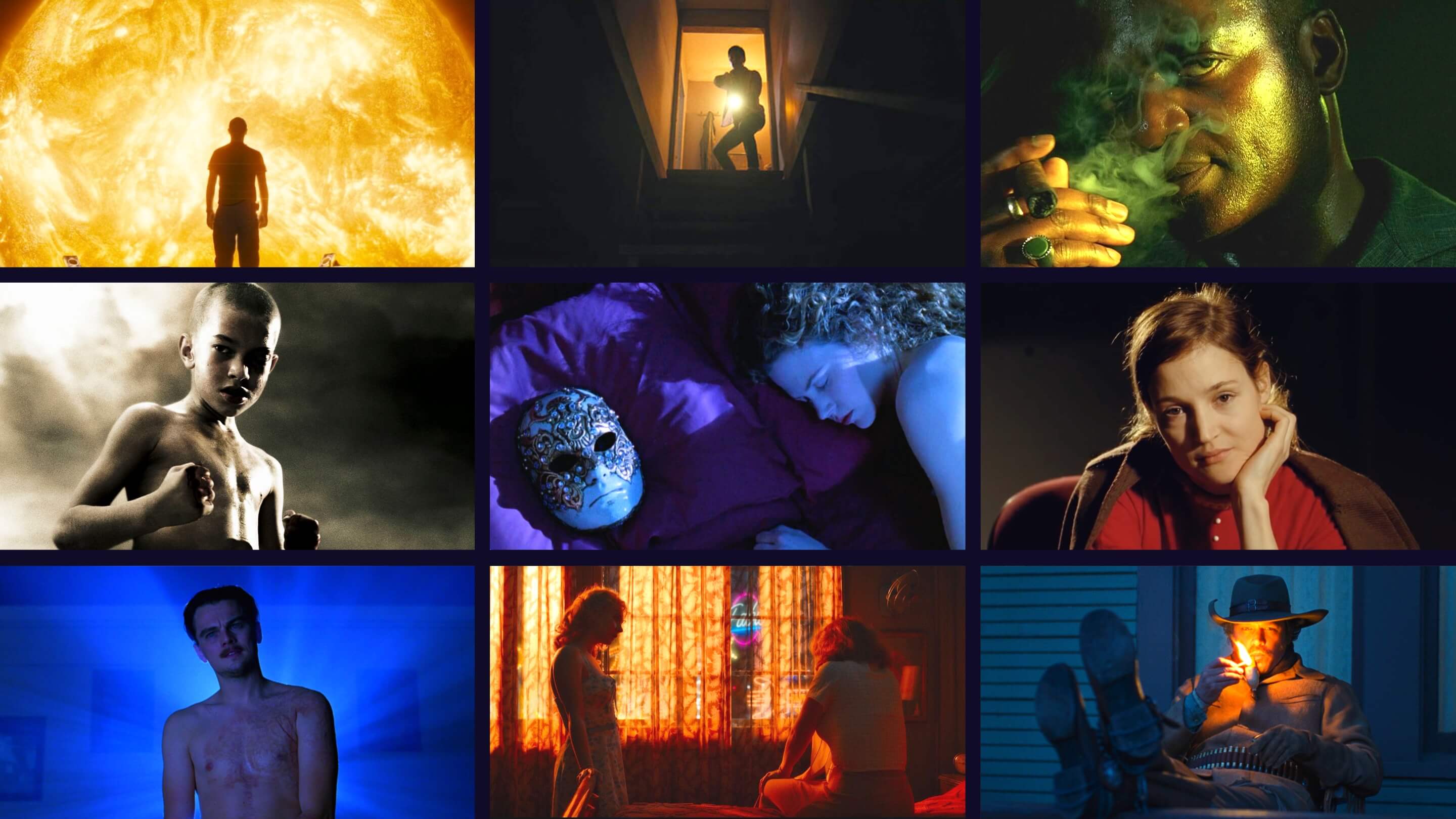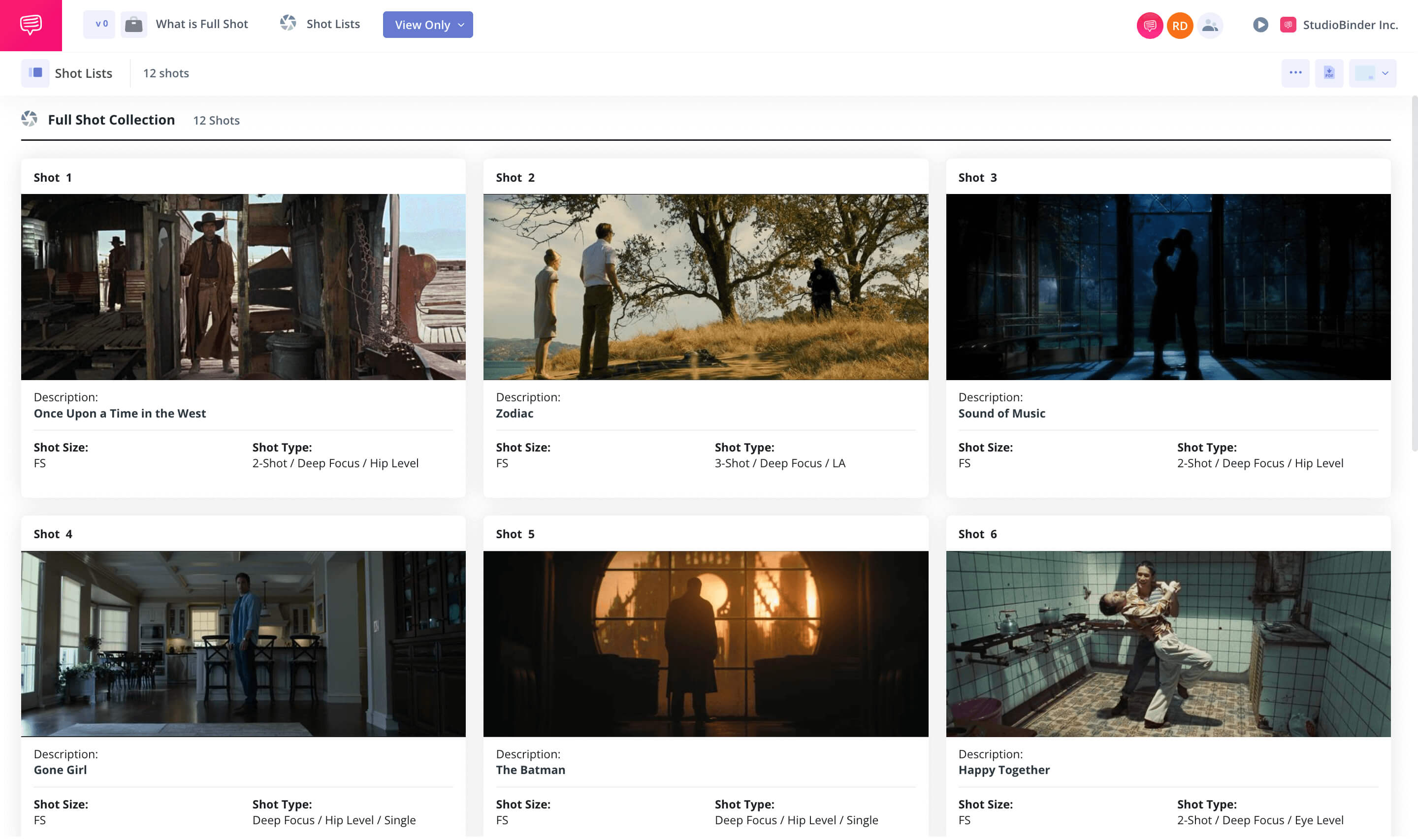Cinematography is a term that includes many elements of filmmaking. If that sounds intimidating, fear not, because today in our beginner’s guide to cinematography techniques, we’re going to look at a bunch of different examples so that you can see what they look like in action. By the end, you’ll know what the major cinematic shots are, and how to capture them. Let’s explore the world of cinematography!
Cinematography Techniques
Three important cinematography rules
Before we examine the camera shots you’ll need in your toolbox, let’s break down three essential film rules and elements.
Practice the 180 Degree Rule

Types of Film Techniques • The 180 Degree Rule
The 180 degree rule is a filmmaking guideline that sets an imaginary line between characters in order to ensure consistent orientation. If you “cross the line,” you may disrupt the audience’s understanding of spatial relations in the scene.
Use the Rule of Thirds

Types of Film Techniques • The Rule of Thirds from Mission: Impossible
The rule of thirds is the process of dividing an image into thirds (nine boxes) in order to control composition. There are many different strategies for composition; it’s generally a good idea to highlight key points of emphasis by having them framed at intersections of lines.
Master Mise en Scène
Mise en scène – translated from French for “setting the stage – is the arrangement of things in a scene, including everything in front of the camera (props, costuming, set design, lighting, hair and makeup, actors, and more).
Now that we’ve examined some important film rules and elements that structure cinematography, let’s look at some different types of shots.
Basic Filmmaking Techniques
1. Close-up
Cinematic Techniques Examples • The Art of the Close-Up
A close-up is a shot taken at a close proximity to a subject or object; if it’s a person, it should be from the shoulders to the top of the head. The close-up connects us to characters, or shows us a clear look at an important element of the mise-en-scène.
Cinematographic Techniques
2. Extreme close-up

Camera Techniques in Film • Extreme Close-Up Example from X-Men
An extreme close-up is a shot taken at such a close proximity to a subject or object that its outer portions are cut off by the frame. Extreme close-ups are used to communicate small details that might go unnoticed; or to highlight specific bodily features, like the eyes.
Types of Film Techniques
3. Long shot
Long Shot Collection • See the collection
The long shot, aka full shot, is a type of camera shot in which a character’s entire body reaches from the top to the bottom of the frame.
We imported a series of examples into StudioBinder’s shot list software – check them out above!
Cinematic Techniques Examples
4. Extreme long shot

Filming Techniques • Extreme Long Shot Example from Lawrence of Arabia
The extreme long shot is a subtype of the long shot in which a character’s entire body is shown from an extreme distance. This type of shot helps to establish a character within a setting.
Cinematographic Techniques
5. Medium shot

Film Making Techniques • Medium Shot Example from Blade Runner 2049
A medium shot is a waist-level shot that’s captured at a medium distance to one or more subjects. This type of shot is a good middle ground between a close-up and a long shot.
Related Posts
Cinematography Techniques
6. Medium long shot

Types of Film Techniques • Medium Long Shot Example from Wonder Woman
The medium long shot is a type of medium shot in which a character’s body (from the top of their head to their knees) stretches from the top of the frame to the bottom of the frame. For this reason, the medium long shot is sometimes referred to as a ¾ shot.
Camera Techniques in Film
7. Zoom shot

Cinematic Techniques Examples • Zoom Shot from Kill Bill
A zoom shot is a type of camera shot in which focal length is adjusted to give the illusion of moving closer to, or further away from a subject. Dolly zoom shots combine focal length adjustment with camera movement in order to create a vertigo effect.
Cinema Techniques
8. Aerial (bird’s eye) shot

Beginner’s Guide to Cinematography • Aerial Shot Examples from Eternal Sunshine of the Spotless Mind
An aerial shot – also known as a birds eye view shot or an overhead shot – is a type of camera shot that’s taken from a high vantage point. This can be achieved handheld; with a gimbal/crane; or with a drone.
Film Making Techniques
9. Dutch angle
Cinematic Techniques • How to Use the Dutch Angle
A dutch angle is a type of camera shot in which the camera is tilted on the x-axis; often looking up at a person’s face, which can create a disorienting or unsettling feeling for the viewer.
Basic Cinematography Techniques
10. Point of view shot
Camera Techniques in Film • The POV Shot
A point of view shot is a type of camera shot from the first-person perspective of a character. This type of shot puts us behind their eyes and connects us to what they’re seeing.
Cinematic Techniques
11. Over the shoulder shot

Filming Techniques • The Over the Shoulder Shot in Film from Titanic
The over the shoulder shot is a type of shot in which the camera is placed over a subject’s shoulder. This camera technique is often used to shoot dialogue.
Camera Techniques
12. Tilt shot
Camera Techniques • The Art of the Pan and Tilt
A tilt shot is a type of camera shot in which a fixed camera swivels up and down on a vertical plane. This type of shot uses motion to redirect the audience’s attention to an element of the scene either at the edges of, or outside the frame.
Cinematography Techniques
13. Camera pan
Beginner’s Guide to Cinematography • The Art of the Whip Pan
A camera pan is a type of camera shot in which a fixed camera swivels left or right on a horizontal plane. Like the tilt shot, the camera pan uses motion to redirect the audience’s attention to an element of the scene either at the edges of, or outside the frame.
Film Techniques
14. Tracking shot
Types of Film Techniques • How to Shoot Tracking Shots
A tracking shot is a type of camera shot that uses motion to “track” a moving subject. This allows us to “follow” them as they travel throughout the scene.
Cinematography Techniques
15. Crane shot

Beginner’s Guide to Cinematography • The Crane Shot
A crane shot is a type of camera shot that is taken by being mounted on a crane. This allows cinematographers to access angles and motion that would otherwise be difficult to achieve.
In Conclusion
Cinematography techniques wrap-up
We’ve covered a lot in this article, but there really are a lot more filmmaking techniques to learn. Watch the rest of the videos in our Shot List series, including episodes on frames rate, camera focus, and camera gear. And you should also check out our Cinematography Techniques playlist with breakdowns of some of the best cinematographers, including Rodrigo Prieto, Hoyte van Hoytema, Darius Khondji, Robert Richardson, and more.
Learning about the cinematography techniques in film is a life-long venture. Hopefully, we could help move down that path just a little bit.
Up Next
What does a cinematographer do?
In this article, we really just skimmed the surface of cinematic techniques examples and all the things a cinematographer does in a film. Let’s get into more specifics of their day-to-day responsibilities and creative decisions.
Up Next: Cinematographer Duties →
Showcase your vision with elegant shot lists and storyboards.
Create robust and customizable shot lists. Upload images to make storyboards and slideshows.


It was interesting to learn more about the light meter and how it can lighten the scene naturally. My wife and I are into recording our family on holidays, and I would say that the thing that gives us the most trouble is lighting. With a light meter, however, you could really make sure that your shooting turns out the way you want it to be. I would love to find out how this works because I want to start recording more things like movies or documentaries as well. Thanks again for the information!
super blog and very useful content
This is amazing!
This is a very useful blog especially for aspiring cinematographers. Thanks for sharing this!
Thanks for the insights about cinematography and on how it works. Your blog is very useful.
I agree, never say fix it in post.
Grrr, I’ve a blog on my website and it sucks.
I actually
removed it, but may need to bring it back. You gave me inspiration!
Keep on writing!
Always Think outside of the box is my favorite among all of the techniques.
I’ll take note of these very amazing tips! Thanks for this, once again.
Hi, i want to commend this post for being informative, clear, and concise. Also, i just want to know why I can't download the pdf file.
It is really wonderful learning for me because I am a associate cinematographer .I say the best technic mention in your website. Very Thank for your website to learn a lot about cinematography.
Please give me a lighting techniques / theory PDF Ebooks
Hi,
Thank you for this insightful article on Cinematography. It is extremely wondrous learning on behalf of me as a result of I’m an associate cinematographer.I say the simplest technic mention in your web site. Terribly give thanks for your web site to find out loads regarding filming.
I also recommend readers to visit my site as well.
Sir how to become a pro camera handling
Studiobinder is the absolute best! love how simple and easy it is to follow. it has turned me into a better film maker. I also used a DLSR Guide to further help me and their program works amazing, everyone should check it out.
This is Great, y’all need to write a book.
Yeah, they show you that and more in film school: way more. The thing is to go to a good one. You can´t learn fillmmaking in internet, i am afraid.
It’s a great source of knowledge; I think it will be helpful for lot of people who are looking for learning more about the cinematography techniques no film school. Thank you very much for sharing this article was really looking forward for something like this.
Ths is so wonderful I learned a lot of things here, I wish to have some more lessons
And atm, with the pandemic, the whole process of filming is a lot more hectic and complicated. I hope the cinema industry never wanes, it's such an important art form.
Thank for this. It's really help a lot <3
Studiobinder is the best learning academy ever made for filmmakers
Awesome! This is probably my favorite chapter; so much to learn!
But, in the "Film Lighting" guide there is a typo; at page 31, the big and bold "Quantity" should be "Quality."
Besides that, it's always a pleasure reading and watching explanatory videos!
Thank you!
You guys saved my life
You are amazing guys
I am a newbie in animation.
Can you make e book about animation like you made for Film
Sorry my English is not good 😅 i hope you understand.
Your channel is better than college/University
And thank you very very very much 😊
You guys are amazing
Amazing amount of learning. Thanks from a novice who was feeling lost, and now not so lost.